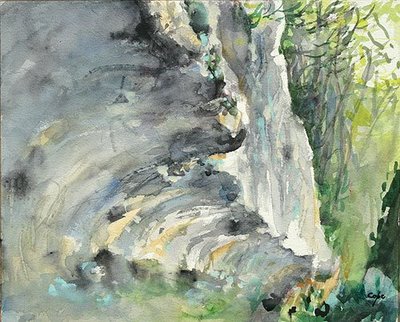Watercolour.
43 x 36cm
© The Artist.
Watercolour & Ink
30 x 40 cm
© Adam Cope
These overhanging rocks gave shelter in the Ice Age. They projected out even more in that period but have collapse over the centuries. A rock wall behind & a rock ‘cieling’ vault overhead. The night fires flickering over the crevasses. If you go to L’Abri Pataud, you can see that the prehistoric inhabitants carved their vaulted cielings. The below rock fragment was found at Catsel-Merle.
dated aurignacian
L’Abri Blanchard
Museum of Castel-Merle
Prehistoric images
Images everywhere? Even on the vaulted overhangs? Like our ‘info-space’… Images everywhere. Image rich & saturated. Images are maps of the world, & function on a different level from the written word. Preliterate prehistory… these little squggly scratchings called ‘writing’. Writing often blinds us from the full use of our eyes. Most people today simply do not have much skill in visual observation, being more at ease reading a newspaper than sitting quietly in a wood just looking, waiting, like a hunter (or a plein-air painter, who also spends long hours, days observing in situ). Hunter-gathers have to use their eyes by necessity.
These places are also wild places, in the deep undergrowth. Rarely under the harrow of man the agricultor. They are not ‘humanised’ landscapes in the way that most of us are familar with. To see uncultivated nature is rare in western europe, as the spread of concrete & agriculture shapes our world of today.
Castel Merle
The actual site of Castel Merle is run by the Castanet family. Marcel Castanet started exacuvating the site in 1910. Monseiur Castanet(fils) is a ‘grand homme de la Prehistoire’ , a Périgordien & savant, who kindly took time to show me around his museum when I was researching what might ( I stress might) be a lunar calendar, found at Castel Merle (will poste about this at a later date).
The museum of Castel Merle in Sergerac is incredible. Some of the many finds from the eleven shelters of Castel Merle are now in America.
The site of Castel-Merle
Pole -Prehistoire.com
(Don’t miss the virtual tour – for which you don’t need to read french)






